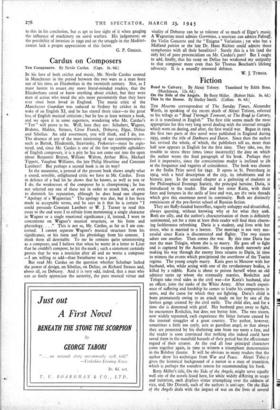Fiction
Road to Calvary. By Alexei Tolstoy. Translated by Edith Bone.
(Hutchinson. 12s. 6d.) "
On the Side of the Angels. By Betty Miller. (Robert Hale. 8s. 6d.) This Is the House. By Shelley Smith. (Collins. 8s. 6d.), THE Moscow correspondent of The Sunday Times, Alexander Werth, in speaking of the recent death of Alexei Tolstoy, referred to his trilogy as "Road Through Torment, or The Road to Calvary, as it is translated in English." The first title seems much the most appropriate for this very long novel dealing with the internal struggle which went on during, and after, the first world war. Begun in 1919, the first two parts of this novel were published in England during 1935, under the title of Darkness and Dawn. Since then the audior has revised the whole, of 'which, the publishers tell us, more than half now appears in English for the first time. They take, too, the trouble to stress three times (once incorrectly) the date on which the author wrote the final paragraph of his book. Perhaps they, feel it imperative, since the conscientious reader is inclined to jib at the frequence and vagaries of coincidence. The book was chosen as the Stalin Prize novel for 1942. It opens in St. Petersburg in 1914, with a brief description of the city, its inhabitants and its historic past. In the second chapter at a gathering of students at the Philosophical Evenings Society, the principal heroine, Daria, is introduced to the reader. She and her sister Katia, with their fates and fortunes in the strife of love and war, are the twin threads which give this enormous novel its continuity. Both are distinctly reminiscent of the pre-Soviet school of Russian fiction.
They are fluffy-headed butterflies, vaguely unhappy and dissatisfied, always questing, without knowing why or for what they seek. Both are silly, and the author's characterisation of them is definitely sentimental, yet for a time at least their reader will find their charm- ing fecklessness refreshing. Dana is a student,- and lives with her sister, who is married to a lawyer. The marriage is not very suc- cessful since Katia is discontented and ffighty. The two sisters adore one another. Then comes the war. By this time Dania has met the man Telegin whom she is to marry. He goes off to fight and is captured by the Austrians. He escapes death narrowly and making his way through the enemy lines returns to Darla, in time to witness the events which precipitated the overthrow of the Tsarist regime. The young couple marry. Katia goes to Moscow with her husband, who, while acting with one of the revolutionary bodies, is killed by a rabble. Katia is about to poison herself when an old admirer turns up whom she eventually marries. Roshchin and Telegin take rival sides in the civil war—for Katie's husband, also an officer, joins the ranks of the White Army. After much experi- ence of suffering and hardship he comes to loathe his companions in arms, and the cause for which they are fighting. Dana's child is born prematurely owing to an attack made on her by one of the lawless gangs created by the civil strife. The child dies, and for a time she is demented with grief. Her husband goes away to fight, he encounters Roshchin, but does not betray him. The two sisters, now widely separated, each experience the bitter fortune caused by the internal struggles of a great country. The author, however, sometimes a little too coyly, acts as guardian angel, so that always they are protected by his sheltering arm from too nasty a fate, and the reader is soon convinced that nothing else indeed could have saved them in the manifold hazards of their period but the affectionate regard of their creator. At the end all four principal characters come together again, in time to witness a triumphant dernonstation in the BolshoY theatre. It will be obvious to many readers that the author drew his -technique from War and Peace. Alexei Tolst3y gives the historical background of a nation in a state of transition, .which is perhaps the soundest reason for recommending his book.
Betty Miller's title, On the Side of the Angels, might serve equally well any of the novels listed here, for while widely differing in scope and intention, each displays virtue triumphing over the oddness of
vice, and, like Disraeli, each of the authors is anti-ape. On the Side IR of the Angels deals with the impact of war on the lives of several
people. An R.A.M.C. hospital in a Gloucestershire village supplies the atmosphere. The two heroines are again sisters, but while less silly than the Russian pair, they are also less charming. This novel explores the struggle between reason and emotion. The theme is ex- cellent and the author aware of its implications, but her technique seems at. fault, for the frame she provides is too shallow for the inner substance of her book.
Who would want to murder a paralysed woman? Shelley Smith, a lively new writer, provides an answer in her very lurid This is the House, which has an exotic island setting for the ingenious sequence of events built up on the lines of the nursery rhyme. Among other ingredients we are given a second murder, a little black magic, some dashing secret service agents, and, indeed, a whole collection of varied characters, including something novel in the line of detectives.
JOHN HAMPSON.



























 Previous page
Previous page